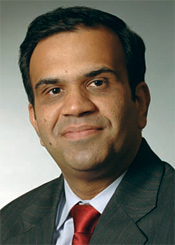
 |
 |
| Simon Saunders, chairman of the Femto Forum |
Femtocells are hailed as the next step in mobile broadband evolution, set to hit European shores commercially later this year to provide more bandwidth, more applications and more services for end users, plus more revenue for operators. Here, Heather McLean takes a look at what femtocells will do for you.
From the half empty voice-pipes of two years ago, networks are now getting jammed with data, while operators push ever-increasing numbers of apps and services towards customers, who are readily buying into the era of the smartphone. Yet, says Simon Saunders, chairman of the Femto Forum, it is difficult to see how mobile broadband speeds can continue their rise without the introduction of femtocells.
“Already there is a growing school of thought that says LTE is approaching the limits, in terms of data rates, of what is physically possible using conventional mobile network design,” claims Saunders. “The solution is to start rolling out vastly more cells in order to re-use spectrum more efficiently, in other words, femtocells.”
Femtocells are essentially cellular wireless access points and are designed to provide in-building coverage for the home or office, explains Nick Karter, senior director for business development at Qualcomm Flarion Technologies, Qualcomm. He elaborates: “Specifically, the in-building signal strength is considerably improved, which will allow users to enjoy substantially higher sustained data rates. As a result of these end user benefits, femtocells can reduce the churn rate, a clear benefit for operators. Femtocells also offload voice and data traffic from macro networks.”
As well as guaranteeing coverage throughout the home and office, enabling the highest quality voice and fastest possible data services using standard mobile handsets, Saunders says femtocells lower the cost of providing mobile services indoors, thereby allowing operators to offer compelling voice and data tariffs that will no longer mean that the landline is the lower cost option. They also enable new mobile applications that take advantage of the presence capabilities of femtocells and the ability to easily connect mobile phone users to the local network and the web, he adds.
Operators dream
Femtocells are by far the most cost effective way for an operator to improve
signal quality inside buildings, states Andy Tiller, vice president of marketing at ip access. He adds that at the same time, femtocells add capacity to the network to help solve the data crunch.
According to the analyst house Informa, 36% of voice calling and 45% of mobile data usage occurs in the home. Femtocells enable operators to immediately increase capacity by shifting this traffic off the existing macro network.
Tiller states: “Because they use the customer’s broadband connection for backhaul, femtocells significantly reduce the network cost of delivering mobile services. They also provide marketing benefits to operators, for example, they support home zone tariffs and enable new services.”
Femtocells therefore have the potential to support viral consumption of mobile broadband usage, explains Anil Kohli, head of femtocell at NEC Europe. “The latest consumer gadgets and PDAs are driving previously unseen levels of mobile internet usage, and across the industry the use of USB HSDPA modems has really taken off, effectively competing with DSL in some markets. Because so much of usage is at home, femtocells could provide an alternative capacity resource supporting the change in the way consumers use the mobile internet and interact with each other via social networking and micro blogs,” says Kohli.
The Femto Forum recently commissioned research from Signals Research Group into the operator business case for femtocells. The research found that even with conservative assumptions, the business case for femtocells is attractive, with the customer lifetime value increasing by as much as 125%, and even higher in certain user scenarios.
In a European household with two subscribers and moderate voice and data usage, the projected lifetime value of the household increases by 56%, from 1,600 euro to 2,500 euro based on operational savings alone. When including less immediate effects, such as attracting other family members and selling new services, the projected lifetime value grows to 3,500 euro, a 120% increase. Overall, the study found that the business case for femtocells is driven more by customer longevity and revenue effects than by variances in the cost of the device itself.
A European operator wanting to provide a reliable 2.5 Mbps in-building service for the most coverage-challenged households, could do so for 320 euro per household if it used a femtocell strategy, whereas providing similar in-home service with the means of the macro cellular network alone would cost 900 euro, according to the research.
New services
 |
| Keith Day, vice president of marketing at Ubiquisys |
For home users
Keith Day, vice president of marketing at Ubiquisys, comments on how the femotcell will influence the home user: “At Ubiquisys we believe that femtocells will change the way people use mobile devices as part of their everyday lives. At home, femtocells promote the mobile phone above the household DECT phone as the first choice for voice quality, convenience and cost. They also provide a free data experience many times faster than the best available outside, which will change mobile browsing behaviour forever. Finally, the ability of the femtocell to provide application presence triggers and home network integration has opened a new category of automatic home-mobile applications.”
Rakesh Vij, assistant president at Aricent, states: “It is easy to see that with better connectivity, users will have a better overall experience and are therefore likely to use mobile broadband services longer and more often. Further, femtocells have potential to spawn a host of locationaware services that could see higher uptake from users since they are more likely to be better targeted and useful to the consumer.”
Paul Callahan, VP business development Airvana, comments: “Today the femtocell is about voice and data, tomorrow the femtocell will be about linking all different devices and helping the user to remain connected in the most appropriate way possible.”
While Kohli agrees: “Femtocells will become a key element of the digital home of the future, allowing access to the home network by the mobile handset, allowing auto synchronisation of the mobile handset to the home server and vice versa. Femtocells will make the handset a key device in home entertainment, home security and surveillance.”
For businesses
On the business user, Day states: “The problem of poor indoor mobile service is worst for businesses, and the only solutions available have been expensive engineeredin solutions such as picocells and DAS. Femtocells change the economics by being based on low cost consumer hardware, and being self-installed by customer IT, just like WiFi. Small companies get affordable indoor mobile for the first time, whilst larger companies can deploy femtocells in a grid to cover buildings of any shape and any size. In all cases, businesses can make more use of mobile in the workplace, because every employee has access to dependable full speed mobile broadband.”
An enterprise femtocell works on exactly the same principle as a residential femtocell. It is a wireless access point covering an in-building area such as an office, shopping mall or train station. Compared to a residential femtocell, it typically covers larger areas with higher power output and will support a higher number of users than a residential femtocell.
For the business user, femtocells ensure lower cost and easier deployment for high bandwidth, as they avoid any need to mount microwave links or towers. Explains Vij, the usage case for businesses will become more pronounced when the Femto Forum finalises standards for femtocells with more channels, such as super-femtocells with eight to 16 channels which are more appropriate for enterprise deployment.
Still waiting
 |
| Rakesh Vij, assistant president at Aricent |
adopters on the technology adoption bell curve. “Widespread adoption will now depend on the price point, which will get increasingly affordable as roll out is ramped up and subscriber volumes grow,” add Vij. “It is the inevitable catch 22 situation faced by any new technology; price points will come down once volumes grow, but companies cant lower price points till volumes grow.”
Vij states that the key question that needs to be answered here is who is going to bear the cost of the femto box. “I do not see customers forking out the money for it. In my opinion, the model that will eventually become popular will be the service provider bearing the cost of the box which will be tied to a service contract.”
That idea will not be a painful one for operators according to the Femto Forum’s research, which showed that cost savings associated with offloading as little as 1.4 GB of HSPA data or 1.3 GB of EV-DO Rev A data per month via the femtocell from a coverage-constrained macro cellular network would justify an operator offering a subscriber a free femtocell.
How to sell
Femtocells will initially be an operator-led play as operators learn about the technology and market, adds Callahan. “However, once operators have the early market experience they need, good mobile dealers will be critical to ensuring mass market adoption. They will be the natural place for the consumer to learn about this new technology and the devices on offer.”
On selling femtocells, Day states: “For consumers, it’s likely that femtocells will be offered as part of their ongoing service bundle together with additional home minutes and data and as such will be offered in a similar manner to handsets. It’s also conceivable that we will see discounts for multiple users in a home subscribing to the same network.
“In the enterprise, our femtocells are plug and play devices that require no engineer set up and can be deployed by the office IT manager,” concludes Day. “As such, they offer a simple way to offer a single unified phone system to companies of all sizes, and are suitable for most direct and partner channels to market.”
What is a femtocell?
The point of a femtocell is firstly to make your mobile phone work better indoors, secondly to reduce the cost of delivering mobile services, and thirdly to provide a platform for new services in the home or office, explains Andy Tiller, vice president of marketing at ip access.
Femtocells improve the experience of using a mobile phone indoors, for both voice and data services. The majority of mobile phone use occurs indoors, where the signal from the outdoor network is diminished as it passes through the walls of the building. Femtocells and picocells generate a much higher quality signal inside the building, which makes voice calls clearer and data speeds faster. This makes femtocells great for new business and consumer applications.
For operators, femtocells add extra capacity to the network at low cost. It’s widely acknowledged that operators cannot offer flat rate, unlimited mobile broadband profitably; they have insufficient network capacity to do so. Therefore operators have introduced fair usage caps. Yet with available bandwidth shared amongst all users in a cell, average data speeds in a congested cell can be slow.
With a femtocell in place, peak data rates can be consistently achieved. Furthermore, because the network cost of delivering mobile data via a femtocell is so much lower than on the macro network, operators can afford to offer truly unlimited, flat rate data.
